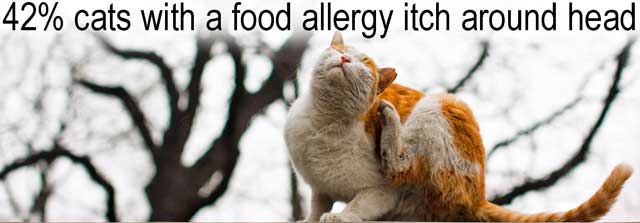What are the signs of an allergic reaction to food for a cat? The symptoms of allergic reactions are often rather vague and it is difficult for people to figure out what caused them and if it’s an allergic reaction it is difficult to work out where the allergen is coming from (an allergen is something that causes an abnormal immune response in the cat). For example, the reaction to an airborne allergen might be similar to a food allergy. However, as stated below a certain combination of signs can point to a food allergy.

I have bumped into two scientific research studies which may help people work out whether their cat is allergic to the food that they are giving him/her.
In one study published in 1998, entitled Possible Food Allergy in a Colony of Cats, the study concerned 26 cats on a Hungarian breeding farm in 1988. In this study the scientists state that hypersensitivity reactions associated with blood eosinophilia most often occur as a result of inhalant or food allergens. Blood eosinophilia is, at a basic level, a raised white blood cell count. The external symptoms were skin lesions and in about 15% of the cats there were gastrointestinal signs. They state that these symptoms can be used as a diagnostic clue to a food allergy. The word “lesion” refers to an abnormality in the skin. It normally refers to a cut or a tear in the skin.
In another study published on Europe PubMed Central entitled Food Hypersensitivity and Cats: 14 Cases (1982-1987), food hypersensitivity was diagnosed in 14 cats.
The clinical signs were as follows:
- pruritus (itching) in all of the cats (100%)
- alopecia (hair loss) in 64% of the cats
- papules in 21%. Papules are raised spots on the skin about about half a centimeter in diameter (across). They can be pink, red or brown
The above signs were the most commonly observed. Pruritus was localised, they say, to the head or neck and ear region in 42% of the cats.
If these symptoms are observed in conjunction with signs of gastrointestinal problems i.e diarrhea and vomiting then on the face of it a likely causes is an allergy to the food that he/she eats.
The scientists were able to make an accurate assessment by feeding the cats a hypoallergenic diet in contrast to the original diet which caused the signs.
They say that the most common allergens were fish and dairy products. Most of the cats in the study were random bred domestic short hairs.
The owners of the cats could not relate the symptoms of food sensitivity to a change in diet. This is interesting. Three of the cats also had other allergies namely flea bite allergy, inherent allergy or a flea collar hypersensitivity.
Another well known veterinary website states that if (a) the symptoms appear in the winter OR (b) they occur all the time it indicates a food allergy (src: Peteducation.com).
I hope this helps. It helped me. There is no substitute for a good vet, however.
